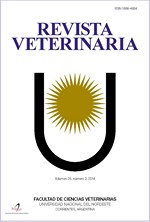Population dynamics of oribatid mites in an endemic zone of sheep cestodosis in Argentina
DOI:
https://doi.org/10.30972/vet.1821904Keywords:
sheep, oribatid mites, population dynamics, intermediate hosts, Anoplocephalidae, Argentina.Abstract
The dynamics in the occurrence of mites intermediate hosts of anoplocephalid cestodes causing mortalities in lambs, was studied in the southwest of Buenos Aires Province (Argentina). Three farms that breed Corriedale and Lincoln sheep, at Puan District, Buenos Aires Province, were visited monthly
(from June to January) to take soil samples from 0 to 6 cm depth. A total of 22 oribatid species
were found. Oribatid males, which are most susceptible to infection with larval stages
of anoplocephalids, were dominant by the end of spring. Zygoribatula lata was the most frequent
and abundant species, representing 70-90% of oribatids found. Further understanding
of the dynamics of oribatid populations in sheep breeding farms, as well as prophylaxis and
treatment alternatives are discussed.
Downloads
Downloads
Published
How to Cite
Issue
Section
License
Copyright (c) 2007 G. Denegri, P. Martinez

This work is licensed under a Creative Commons Attribution-NonCommercial 4.0 International License.
Revista Veterinaria (Rev. Vet.) maintains a commitment to the policies of Open Access to scientific information, as it considers that both scientific publications as well as research investigations funded by public resources should circulate freely without restrictions. Revista Veterinaria (Rev. Vet.) ratifies the Open Access model in which scientific publications are made freely available at no cost online.











.jpg)
.jpg)



